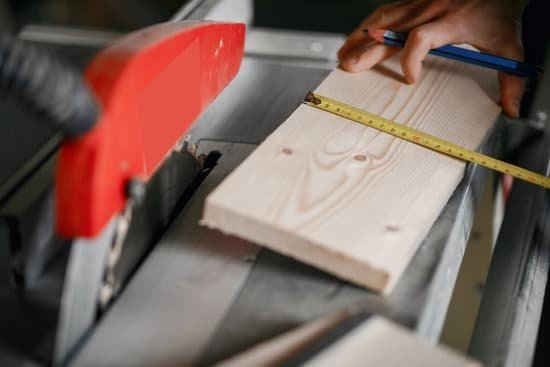Woodworking is a rewarding and fulfilling hobby, but many enthusiasts face the challenge of not having a dedicated shop space for their projects. In this article, we will explore how to woodwork without a shop, offering tips, tricks, and essential information for creating a functional at-home woodworking workspace. Whether you live in an apartment, dorm room, or simply lack the space for a traditional workshop, this guide will help you pursue your passion for woodworking in any setting.
Setting up a designated workspace at home is the first step towards successful non-shop woodworking. We’ll cover tips for creating an efficient and organized area that accommodates your projects without requiring a large footprint. From selecting essential hand tools to utilizing portable power tools, we’ll provide guidance on how to equip your at-home workshop with the necessary tools while maximizing limited space.
Safety is paramount when woodworking in a non-shop environment. We’ll share important measures to ensure safe practices while working with wood at home. Additionally, we’ll explore innovative DIY workbench solutions and clever storage ideas to make the most of limited space.
And finally, we’ll provide inspirational project ideas with detailed instructions that are perfect for small-scale woodworking without a dedicated shop. Whether you’re new to woodworking or an experienced hobbyist looking to adapt to limited space constraints, this article offers invaluable insights and solutions for pursuing your passion.
Setting Up a Designated Workspace at Home
When it comes to woodworking without a dedicated shop, one of the first challenges is finding a suitable workspace at home. Without the luxury of a spacious workshop, woodworkers need to get creative with their available space. Whether it’s a corner of the garage, a small spare room, or even just setting up a workbench in the backyard, there are several tips and tricks for creating a functional area for woodworking at home.
Maximizing Space
In limited space situations, it’s important to maximize every inch of available area. This can be achieved by using wall-mounted storage solutions such as pegboards or shelving units to keep tools and materials off the floor. Additionally, foldable workbenches or tables can be utilized to save space when not in use.
Creating a Dust-Free Zone
Woodworking can create a lot of dust and debris, so it’s essential to create a designated area that can be easily cleaned. Setting up in an area with hard flooring rather than carpeting can make cleanup easier, and investing in a quality dust collection system or portable vacuum can help keep the workspace tidy.
Optimizing Lighting and Ventilation
Good lighting is crucial for any woodworking project, so finding an area with natural light or installing bright overhead lights is important. Adequate ventilation is also essential for working with wood indoors – opening windows or investing in an air purifier can help maintain air quality while woodworking at home. With these tips in mind, woodworkers can set up an efficient and functional workspace even without a dedicated shop.
Essential Hand Tools for Basic Woodworking Projects
For those who don’t have the luxury of a dedicated woodshop, there are still plenty of opportunities to engage in small-scale woodworking projects right at home. The key to successfully woodwork without a shop lies in having the essential hand tools for basic projects. These tools are not only compact and easy to store, but also versatile enough to handle a wide range of tasks.
Measuring and Marking Tools
Accurate measurements and markings are crucial in woodworking. A good quality tape measure, combination square, and marking gauge are indispensable tools for ensuring precision in your projects. Whether you’re cutting, drilling, or assembling pieces, these tools will help you achieve the perfect fit and finish.
Cutting Tools
A set of high-quality saws is essential for any woodworking project. A backsaw is ideal for making straight and precise cuts, while a coping saw is perfect for intricate curves and shapes. Additionally, having a sharp chisel set is essential for refining joints and edges.
Joining Tools
When it comes to connecting pieces of wood together, having the right joining tools is crucial. A hammer, screwdriver set, clamps, and a basic hand drill should all be part of your toolkit. These tools will allow you to secure pieces firmly and accurately during assembly.
By investing in these essential hand tools for small-scale woodworking, anyone can tackle projects at home without the need for a full-fledged shop. With careful planning and organization, it’s possible to create beautiful woodwork even within limited space constraints.
Utilizing Portable Power Tools
When it comes to woodworking without a dedicated shop, portable power tools are essential for creating quality projects in a non-shop setting. Here are some tips on how to choose and use power tools for woodworking at home:
- Consider the space: Since you don’t have a full workshop, it’s important to choose power tools that are compact and easy to store. Look for tools that can be easily set up on a workbench and then stored away when not in use.
- Choose versatile tools: Opt for power tools that can perform multiple functions, such as a combination drill and driver or a multi-purpose saw. This will help you maximize your limited workspace.
- Invest in quality: While it may be tempting to go for the cheapest option, investing in high-quality power tools will ensure better results and longer-lasting equipment.
Once you’ve selected the right power tools for your at-home woodworking setup, it’s important to use them safely and effectively. Here are some tips for using portable power tools in a non-shop setting:
- Read the manual: Before using any new power tool, take the time to read through the instruction manual carefully. Familiarize yourself with the tool’s features and safety guidelines.
- Wear protective gear: Always wear safety goggles and ear protection when operating power tools. For certain tools, such as a circular saw or angle grinder, consider wearing gloves and a dust mask as well.
- Maintain your tools: Regularly check your power tools for signs of wear or damage, and perform any necessary maintenance to keep them in good working condition.
By choosing the right portable power tools and using them safely, you can effectively woodwork without a dedicated shop and create beautiful projects from the comfort of your home.
DIY Workbench Solutions
For many woodworking enthusiasts, not having a dedicated shop or workspace can pose a challenge when it comes to pursuing their craft. However, with some creativity and ingenuity, it is possible to build a functional workbench in a limited space at home. Whether you live in an apartment, condo, or small house, there are various DIY workbench solutions that can help you optimize your available space for woodworking projects.
One popular option for those who need to woodwork without a shop is the fold-down workbench. This type of workbench can be mounted on a wall and easily folded up when not in use, saving valuable floor space. It typically consists of a sturdy wooden surface supported by brackets that allow it to be securely attached to the wall. When folded down, it provides a stable and ample workspace for cutting, sanding, and assembling smaller projects.
Another space-saving workbench solution is the multi-functional bench with built-in storage. This type of workbench is designed to serve as both a workspace and a storage unit for tools and materials. By incorporating shelves, drawers, and compartments into the design, woodworkers can maximize their available space while keeping everything they need within arm’s reach. Additionally, some designs feature adjustable height settings and collapsible components to further optimize the use of limited space.
Finally, for those who have outdoor spaces such as patios or balconies but no indoor workshop area, there are portable workbench options that can be set up and easily stored away when not in use. These benches are often lightweight but sturdy and may include features such as clamps and vices for securing materials during projects.
It’s important to note that regardless of which DIY workbench solution is selected for woodworking at home without a shop, ensuring stability and safety should be top priorities during construction and use.
| Workbench Solution | Description |
|---|---|
| Fold-Down Workbench | Mounted on a wall; folds up when not in use; offers stability and ample workspace |
| Multi-Functional Bench with Built-In Storage | Serves as both workspace and storage unit; incorporates shelves, drawers, compartments |
| Portable Outdoor Workbenches | Lightweight yet sturdy; suitable for outdoor spaces; includes clamps/vices for securing materials |
Safety Measures for at-Home Woodworking
Working on woodworking projects without a dedicated shop presents unique challenges, particularly when it comes to safety. However, with the right precautions and measures in place, it is possible to safely engage in woodworking at home. Whether you are working in a garage, on a patio, or even in a small apartment, these tips will help you stay safe while pursuing your woodworking passion.
To ensure safety while woodworking in a non-shop environment, consider the following tips:
1. Personal Protective Equipment (PPE): Invest in essential PPE such as safety goggles, dust masks, and ear protection to safeguard yourself from potential hazards.
2. Ventilation: If working indoors, make sure the area is well-ventilated to prevent exposure to harmful fumes and airborne particles. Consider using a dust collector or air filtration system to maintain air quality.
3. Fire Safety: Keep a fire extinguisher nearby and be mindful of flammable materials present in your workspace. Avoiding the use of flammable chemicals unless absolutely necessary for a project can also decrease fire risks.
4. Tool Maintenance: Regularly inspect and maintain hand tools and power tools to ensure they are in good working condition. Dull blades and worn-out equipment can lead to accidents.
5. Education: Take the time to educate yourself about proper tool usage and best practices for woodworking safety. There are many resources available online and through local woodworking groups that can provide valuable information.
By implementing these safety measures, woodworkers can minimize risks and enjoy their craft without compromising on safety standards even without a traditional shop setting.
Storage and Organization Solutions
When working on woodworking projects without a dedicated shop, storage and organization become even more crucial. With limited space, it’s important to find clever ways to store and organize your woodworking materials and tools in order to maximize efficiency and maintain a safe work environment.
One effective solution for storing small woodworking materials such as screws, nails, and bolts is by using compartmentalized containers. These can be easily stacked or placed on shelves, allowing you to see and access your small items without taking up much space. Another option is to install wall-mounted organizers with bins or baskets, providing easy access to frequently used items while keeping them off your work surface.
For larger tools such as hand saws, chisels, and clamps, pegboards are a versatile storage solution. By hanging the tools on hooks or customized holders, you can keep them neatly organized and within reach. This not only saves space but also helps prevent accidents by keeping sharp objects safely stored away when not in use.
In addition to these storage solutions, creating designated zones for specific tasks can help optimize your workspace. For example, setting up a sharpening station for maintaining your blades or a finishing area for applying stains and varnishes can help streamline your workflow in an at-home woodworking setup.
| Storage Solutions | Benefit |
|---|---|
| Compartmentalized containers | Easy access to small items without taking up much space |
| Wall-mounted organizers | Keeps frequently used items off work surface |
| Pegboards | Neatly organizes tools while saving space |
Inspirational Project Ideas
In conclusion, while woodworking without a dedicated shop may present challenges, it is certainly possible to create beautiful and functional wood pieces from the comfort of your own home. By setting up a designated workspace, investing in essential hand tools and portable power tools, and getting creative with DIY workbench solutions, you can embark on woodworking projects even without a traditional shop.
It is important to prioritize safety measures and implement clever storage and organization solutions to make the most out of limited space.
One key takeaway from this guide is the importance of creativity and resourcefulness when it comes to woodworking without a shop. With the right mindset and a willingness to adapt, you can turn any corner of your home into a productive woodworking space. Whether it’s carving small decorative items or building furniture pieces, there are plenty of inspirational project ideas that can be accomplished without the need for a dedicated shop.
Ultimately, with the information provided in this guide, you have all the tools and knowledge necessary to start your woodworking journey at home. By following these tips and utilizing the detailed instructions and project ideas included in this article, you can discover how rewarding it can be to engage in woodworking even without a traditional shop setup. Happy woodworking.
Frequently Asked Questions
How Do I Get Into Woodworking Without a Workshop?
You can get into woodworking without a workshop by starting with smaller projects that can be done with basic hand tools. Look for DIY woodworking kits or small projects that can be completed on a table or workbench. Additionally, consider setting up a designated space in your garage, patio, or balcony to work on these smaller projects.
Can I Do Woodworking in My House?
Yes, you can do woodworking in your house as long as you have the proper space and ventilation. Small woodworking projects can be done on a table or workbench inside your home, but it’s important to consider any potential noise and dust that may be produced during the process.
If possible, designate a specific area of your home for woodworking to minimize disruption.
Can You Do Woodworking Inside?
Woodworking can definitely be done inside, but it’s important to take necessary precautions for ventilation and dust control. Consider using portable dust collection systems and opening windows for ventilation while working on indoor woodworking projects. It’s also a good idea to lay down protective coverings on surfaces to prevent damage from tools and sawdust.

Hi everyone! I’m a woodworker and blogger, and this is my woodworking blog. In my blog, I share tips and tricks for woodworkers of all skill levels, as well as project ideas that you can try yourself.





